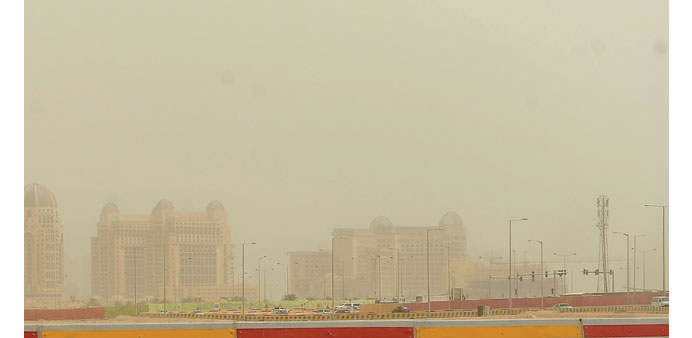AFTERMATH: The day after, the severity of the dust storm in April in Qatar had declined, but one could still feel the sand in the air. The dust storm which struck the Levant region on September 7 and 8 was of a similar intensity, with many people without access to the protection offered by concrete structures.
By Steff Gaulter
On September 7, a huge dust storm erupted in parts of the Middle East. Turkey, Syria and Jordan were all badly hit, and the next day, the dust storm grew to affect an even larger area.
This was a dust storm which rivalled Qatar’s April storm in its intensity. For those of you who weren’t in here on April 1, frankly you were lucky. I can honestly say that in the 8 years that I’ve lived in Doha, I have never seen a sandstorm like it. I knew there was a storm forecast, but didn’t appreciate how severe it was going to be.
In April, I knew the storm had hit Doha, because I could taste the dust in the air, despite the fact that I was indoors with all the doors and windows shut. Alarmingly when I looked across the room, we could see the dust streaming under one of our lamps. At this point I realised it must be a monster of a storm, so looked out the window, but couldn’t even see across the road.
The storm continued to get worse during the night and at 2am, I woke up and the air was horribly polluted. The most worrying part was that my baby was just three months old at the time, and I hated to think what the dust was doing to his tiny lungs. My husband sprang into action, sealing the window with cling film and putting wet towels under the doors. Meanwhile I sprayed the room with water to help the dust settle. It made a huge difference, but we decided then and there to buy an air purifier as soon as possible.
The dust storm which struck the Levant region on September 7 and 8 was of a similar intensity, but the impact was very different. In Qatar we are lucky enough to live in brick buildings, which are sturdily built to withstand the elements. The dust gets into our homes through any gaps it can find, but the walls protect us from the wind and the worst of the conditions. In the Levant region there are millions of families who have been displaced by violence. Tens of thousands of these people live in tents, and you can imagine what little protection a tent would offer against a roaring sandstorm.
Sometimes it’s hard to remember that people who live in refugee camps are just like us. They have brothers and sisters, and they have children and small infants. They all struggle with the summer heat and they try to keep their homes free from dust. There would have been a number of parents in the camps with small babies when the dust storm hit, but for them, there was no chance of sealing their tent against the wind. They had no choice but to endure the wrath of nature, and an air purifier would have been a distant dream.
The dust storm was so intense that it wasn’t only those living in refugee camps who suffered. People were advised to stay indoors as the storm raged, especially the young and the elderly. Many of those who ventured onto the streets wore surgical masks, but despite the precautions, the storm took its toll; a number of people were killed and hundreds were hospitalised.
The huge volume of dust was triggered by an area of low pressure which was located over the region. The winds dragged in air from over eastern Syria forcing it west, towards the Mediterranean coast. The air passed over a large agricultural region in Syria, northeast of Raqqa, and also over several salt flats along the Syria-Iraq border, both of which are well-known sources of the fine particles required for a dust storm.
The reason agricultural areas provide plentiful amounts of dust is because of the techniques involved in farming. Turning soil, removing vegetation, grazing by livestock and draining surface water are all necessary in order to grow the food we eat. However, they also make it easier for winds to pick up particles and propel them into the atmosphere.
The worst of the dust storm was on September 7, originally in Syria, then spreading into northeastern Jordan. Fortunately the most severe conditions were largely confined to the less populated parts of the Syrian Desert. However, it did also spread through some of the more populated parts of Syria, where residents have already endured years of heavy shelling, including the city of Homs.
The storm then eased slightly in intensity as it spread in size, extending across the region as far west as Cyprus and Egypt, and as far south as Saudi Arabia. The extensive cover of the storm, together with the sluggish atmospheric movements of summer, ensured it took several days to clear the dust and conditions remained poor for a number of days.
As we all know from living in Qatar, dust storms are a regular hazard of living in a desert region. However, the dust storm of April is not one I would like to experience again in a hurry. There are some studies which suggest that the destruction of wetlands in the Tigris and Euphrates will increase the intensity of dust storms in the Gulf in the future. When the next one hits, I will try to be grateful that at least I am not living in a tent.



